All grounding articles
Why grounding is so much more important than most people think
Grounding errors can cause electrical shock, fires, equipment damage, and power quality problems that can cause systems, circuits, and equipment to operate improperly.
The hidden hazards of ground faults in PV systems
Why DC ground faults in PV systems are hidden hazards you need to detect before it’s too late. Find the blind spots in PV systems. Solar ground fault troubleshooting.
Why Ground, Why Test?
Poor grounding contributes to unnecessary downtime, but a lack of good grounding is dangerous and increases the risk of equipment failure. Without an effective grounding system, you could be exposed to the risk of electric shock, not to mention instrumentation errors, harmonic distortion issues, power factor problems and a host of possible intermittent dilemmas. If fault currents have no path to the ground through a properly designed and maintained grounding system, they will find unintended paths that could include people.
Selective Measurement
Selective testing is very similar to the Fall-of-Potential testing, providing all the same measurements, but in a much safer and easier way. This is because with Selective testing, the earth electrode of interest does not need to be disconnected from its connection to the site! The technician does not have to endanger himself by disconnecting ground, nor endanger other personnel or electrical equipment inside a non-grounded structure.
Stakeless Measurement
The Fluke 1625 earth ground tester is able to measure earth ground loop resistances for multi-grounded systems using only current clamps. This test technique eliminates the dangerous, and time consuming activity of disconnecting parallel grounds, as well as the process of finding suitable locations.
Reassessing airport tower lightning protection systems
Reassessing airport tower lightning protection systems with checklist for ensuring reliable lightning protection, with aid of ground resistance
Some grounds for suspicion
Earth ground testing definitions and methods: grounding and bonding, purpose of the earth ground, Fall of Potential test, stakeless ground testing
Measuring Ground Resistance
How to measure ground resistance. When conducting a grounding audit of a central office there are three different measurements required.
Testing electrical bonds
Expert, Chuck Newcombe, revisits techniques from 1963 for testing the electrical bonds in a grounding system and compares them with today's tools and methods.
Measuring ground loop resistance without stakes
Normal earth ground measurement involves disconnecting parallel grounding rods, "planting" several auxiliary grounding stakes, and using a earth ground tester to calculate the resistance of grounding system electrodes. Sometimes, though, there isn't anywhere to plant the grounding stakes - such as inside a building, at a cell phone substation, or on power pylons. What then?
Grounding separately derived systems
As I promised in my last column, this "Solid Ground" column deals with transformers and grounding. Let's start by addressing some definitions. Opinions differ on the "official" definition of "distribution" transformer.
Earth ground testing for mine sites with Fluke 1625
All mine sites have grounded electrical systems, so that in the event of a lightning strike or utility overvoltage or ground fault, the current would be able to find a safe path to earth or the neutral of the transformer.
Chasing "ghost" trips in GFCI-protected circuits
This issue of "Solid Ground" talks about ground fault circuit interrupters (GFCIs), why they are necessary, and how to troubleshoot GFCI-protected circuits.
